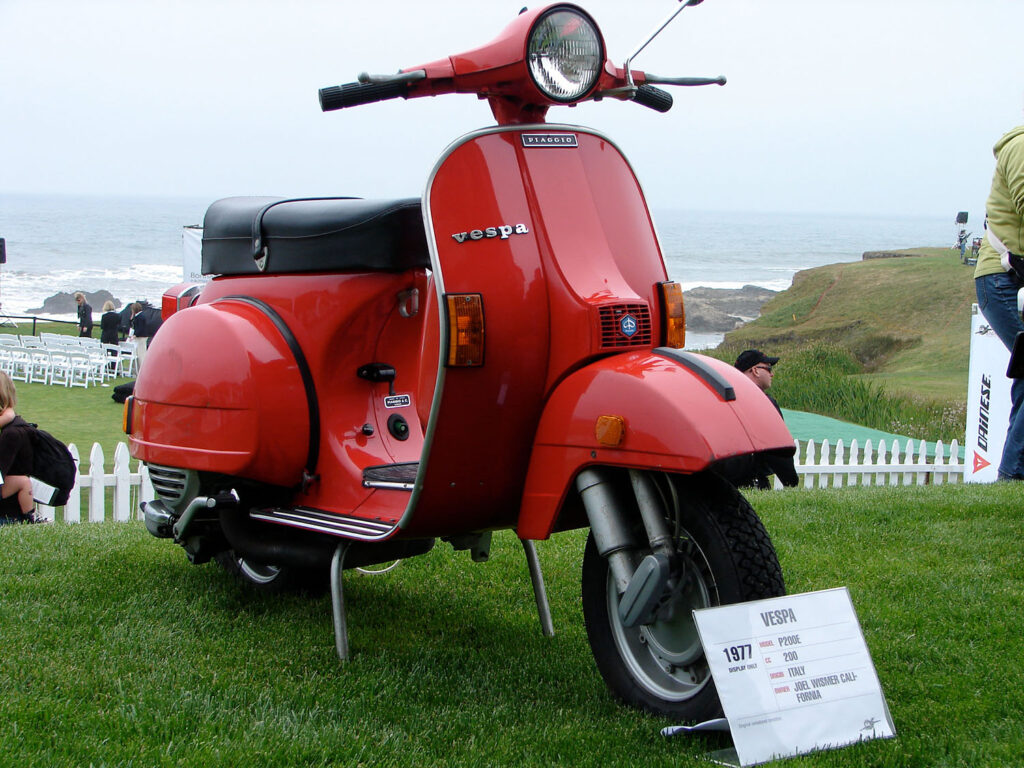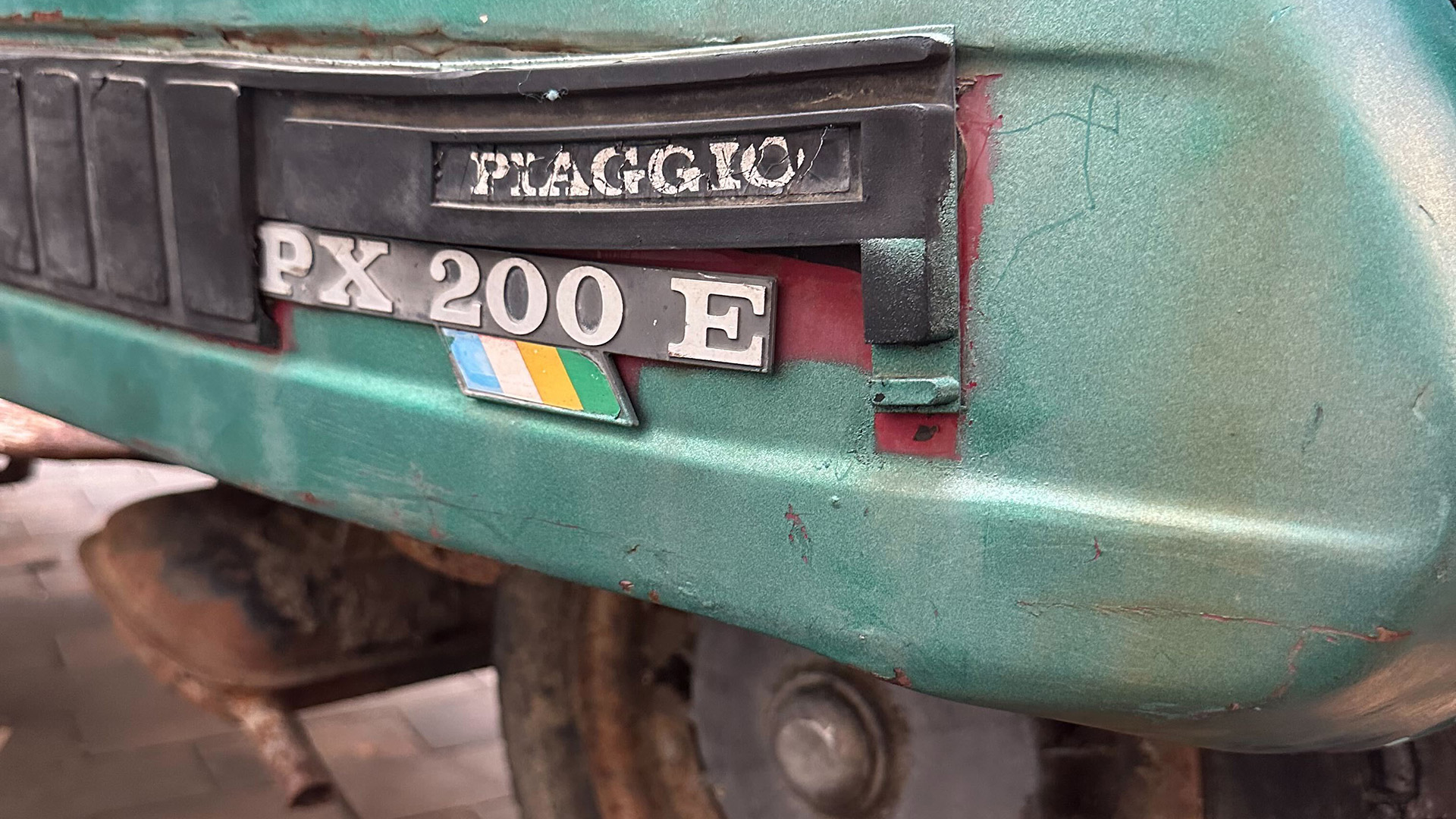The Vespa P 200 E is a legendary Vespa scooter model. With its striking design and powerful engine, it quickly became a popular model among Vespa fans. In addition to its powerful engine, the P 200 E was also known for its modified design, which included a larger frame, angular hoods and a more voluminous leg shield. With a top speed of just under 105 km/h, the Vespa P 200 E offered both performance and style for those looking for a distinctive scooter.
What do the letters in Vespa P 200 E stand for?
First, let’s clear up a common misconception:
The “E” after the model designation stands for “electronic thyristor ignition (Elestart)”. Some Vespisti assume that the “E” stands for an electric drive. That would be an e-scooter, which is not the subject of this article.
The “P” in the name stands for Piaggio and the number 200 indicates the cubic capacity of the engine in cubic centimetres (cc). The Vespa P 200 E was produced from 1977 to 1982.
This model was first presented at the 1978 motorcycle trade fair in Cologne and was subsequently available for purchase. It attracted a great deal of attention and quickly became a popular model among Vespa fans.
Revolutionary design – for its time
Unlike the German version, the first Italian version “Senza Frecce” had no indicators (direction indicators). On the German model, the indicators were attached to the side edges of the leg shield. Also interesting: the electrical supply for the indicators was routed through the safety pin on the hood.
Contrary to Piaggio/Vespa’s usual strategy of leaving the design largely unchanged, the P 200 E was given a different design above all:
- physically larger frame
- angular hoods in contrast to previous models
- enlarged, almost square leg shield
- more voluminous mudguards and cascade
- the horn visible on previous models disappeared behind the cascade
- the cascade now concealed a massive distribution segment for power cables
- voluminous luggage compartment on the other side of the leg shield

Engine and speed
The engine of the P 200 E has a displacement of 200 cc and an output of 10 hp. It is a 1-cylinder 2-stroke engine. With this engine power, the Vespa P 200 E reached a top speed of just under 105 km/h.
In the summer of 1978, speed tests were carried out in which the P 200 E achieved impressive results. These took place on a test site of the tire manufacturer Pirelli in the municipality of Vizzola Ticino/Lombardy. The thermometer showed 13 degrees Celsius on that day (January 24, 1978) and the test model P 200 E had the number VSX1T 1389.
Here are the interesting results:
- 100 m in 7.5 seconds
- 200 m in 11.9 seconds, speed reached 89.55 km/h
- 300 m in 15.7 seconds
- 400 m in 19.3 seconds, speed reached 104.04 km/h
The maximum speed of just under 105 km/h was rarely reached in daily use. In general, values of 90-95 km/h were measured on the highway, on a straight stretch, without a headwind.
A digital speedometer was also installed in order to achieve the most accurate measurement results possible. The wheel circumference was also included in the conversion formula.
For all the necessary spare parts and attachments for the Vespa P 200 E, it is worth taking a look at the SIP Scootershop.
Successor to the success
The P 200 E was replaced by the PX 200 E (1982 – 1986). This time again true to the usual motto: no significant visual changes, except for the
- 20 mm fork
- internal side cover fasteners
Technical innovations were successively introduced on other new models:
- PX 200 E/Lusso (1983 to 1995), fuel gauge, separate lubrication
- PX 200 E/GS (Grand Sport), same cylinder (displacement), but 12 hp
- PX 200 E/Elestart, received an electric starter
From 1998, there was a version with hydraulically actuated disc brakes and halogen headlights.
Good to Know
- The Vespa P 200 E was the most powerful model in the “New Line”. With its introduction in 1977, it revolutionized the market and enjoyed great popularity in the following years.
- The Piaggio Group built a total of 160,000 P 200 E vehicles between 1977 and 1983. This high production figure demonstrates the strong demand and success of this model.
- In addition to the P 200 E, the P125 X was also launched in Italy in 1977. Both models conquered the market and were enthusiastically received by Vespa fans.
- One year later, in 1978, the P 150 X model was introduced. This model completed the range and extended the choice available to customers.
- The Vespa P 200 E and its sister models P125 X and P 150 X shaped the Vespa era of the 70s and 80s and are still highly sought after by enthusiasts and collectors today.



